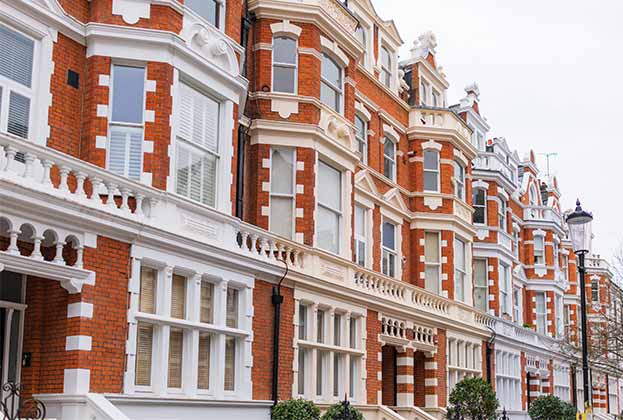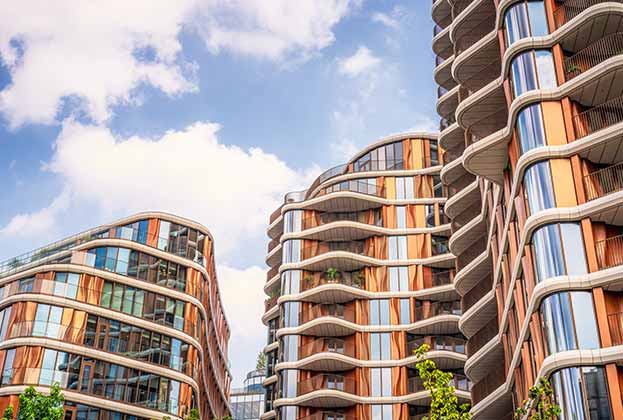Our agents discuss what makes prime central London districts and micro-hoods so desirable
Mayfair
The best addresses are still generating record prices
Mayfair’s sales and lettings markets have remained resilient, despite uncertainty over the changes to "non-doms" status and taxation, forecast to come in the Autumn Statement.
Properties at the best addresses are going for record prices per square foot – homes on Grosvenor Square, Mount Street and Charles Street can still whip up a frenzy. Buyer demand is coming from across the globe, including India, the US and Europe.
There remains a lack of best-in-class stock between £5 million and £10 million, intensifying the supply-demand imbalance in this price bracket.
The busiest part of the sales market currently is the lower end (between £1 million and £5 million) in areas such as Shepherd Market, as buyers seek out a bolthole in central London. This is currently accounting for 50 per cent of sales.
The Grosvenor Estate is working hard to curate the luxury retail offering, while quirky hospitality spaces arrive too, such as the wine bar at Farm Shop Mayfair on South Audley Street, which opened in January, or Abajo, the Colombian offering underneath Michelin-starred HUMO. KOYN Thai opened on Grosvenor Street this summer and Akira Back took up residency in the Mandarin Oriental Mayfair.
In terms of new developments, Phones 4u founder, John Caudwell is building what is set to be the world’s most expensive residential-only scheme. 1 Mayfair will attract the world’s elite when they go on sale.
Commercial property developments are feeding into the market too, with the construction of Blackstone’s 226,000 sq ft European headquarters underway on Berkeley Square, extending Mayfair’s status as an international finance hub, and bringing with it more demand in sales and lettings.
After strong performance last year, it is encouraging to see continued rental growth in the market. Transactions are up year on year; more deals are being done off the market than ever before as people feel their way through 2024 and often opt to ‘try before they buy.’
The average tenancy is getting longer as tenants look for stability and renewals have gone up too. This suggests a more stable market, despite the high levels of activity. Transaction numbers are higher than last year, but as tenants start to shop around a little, this is suppressing rent rises.
These landlords – some accidental – do not necessarily need to rent their home out. If they don’t get the rental price they want, they won’t fill the property. This is leading to a tricky market. Patience and diligence are needed to put together a deal.
Our sales and lettings teams are collaborating more than ever to help our landlords and sellers determine value on both ends.
KNIGHTSBRIDGE, SLOANE STREET AND BELGRAVIA
Belgravia back in the spotlight
The Belgravia of 15 to 20 years ago is almost unrecognisable now. It was a quiet residential patch in the heart of central London, the stomping ground of politicians and cluttered with international embassies. Arguably, it had a strong sense of history rather than a strong sense of place.
Following significant improvements in the streetscape, public realm and amenities, an increasing number of tenants and homebuyers are now specifying Belgravia as where they want to live. That has been one of the key traits of 2024.
Much has changed. Pavilion Road, for example, was a narrow mews street behind Sloane Street with a collection of small homes that had become a place to park cars. It has been reimagined as a high street over the last few years and is now a destination street with hand-picked boutique retailers behind restored facades. The upgrades to Elizabeth Street and Motcomb Street mean that residents now want to grab a coffee and shop on their doorstep in Belgravia rather than head off to Chelsea’s King’s Road.
Other pockets benefitting from a carefully curated upgrade include Knightsbridge itself. The shopping experience has been spruced up. The pavements have been widened, creating a clean flow from the tube to the stores.
Key retailers have been placed in prominent positions. The new Apple store is more demonstration space than shop and a new Burberry flagship store has helped put Knightsbridge back on the map for shoppers. Above street level is a suite of luxurious apartments, delivered by Knightsbridge Estate, redeveloped and considered to be London’s most exclusive build-to-rent proposition.
This wave of change is sweeping down Sloane Street. The £46 million upgrade was announced in 2019 but delayed due to the pandemic. Currently in the throes of construction, when completed the pavements will have been broadened and planted with pocket forests, to create a green, low-carbon boulevard that runs down to Sloane Square. The brands have responded accordingly: Christian Dior and Louis Vuitton have upsized their stores. This should follow through to Sloane Square making way for a more cosmopolitan cafe culture with tables spilling out onto the pavements.
The early election has led to a busy summer in Belgravia’s collection of charming urban enclaves which run from Chelsea Barracks to The Goring and up to Knightsbridge. The area has a real bustle about it, with strong demand from Middle Eastern buyers and the return of the lateral homes market.
Lettings is coming off the back of a prolonged purple match in the wake of the pandemic. Once international travel opened back up, demand and rents went wild. It was a once-in-a-generation market. The hype has now dissipated, rent rises are nominal and tenants are more prudent. The market has moved on.
Despite this, and compared to pre-Covid times, lettings is still in a very good place. Demand for flats over houses is back (in both sales and lettings) with the lower prime end the most active. A good quality one-bedroom flat will get three offers by the end of launch day. The corporate ex-pat market (those being relocated back by their companies) is busy, as is the diplomatic market and we await the return of the students.
ST JOHN’S WOOD
New developments have brought a polish to St John’s Wood
Last year, the sales market in St John’s Wood was strong on all fronts, from £5 million to £20 million, and peppered with noteworthy house sales in the £40 million to £60 million bracket. International and domestic buyers were all pounding the pavements.
2024 has been different. In January, there was a backlog of deals being processed, but then it went quiet above £20 million until after the election. Top-end buyers have been concerned about the cost implications of a change in the "non-doms" policy by Labour and shaken by the procession of elections around the world – from Taiwan to Pakistan to, of course, the US election yet to come in November. This all fed into a pervasive sense of unease.
In July however, the sales market kicked off again as the decisive Labour win gave vendors and buyers confidence. People were bored of waiting and the same old drivers harried them to transact in St John’s Wood: the schools, the proximity to vast green space (Hampstead Heath, for example) and fear of pollution in more central spots. There is also a view that this part of north west London is less transient with a more settled, full-time community. This pulls families to the area.
More stock will come with the development of St John’s Wood Square, the transformation of the former Royal Horse Artillery headquarters. This Grade II listed building and five-acre site, between St John’s Wood underground station and Primrose Hill will deliver 179 new luxury three- and four-bedroom homes to the area. This is likely to appeal to families and investors, given strict regulations set by Westminster Council that make it complicated for developers to knock through and create palatial lateral apartments.
Other boutique developments are bringing a polish to the area not seen previously. One St John’s Wood comprises 98 luxury homes overlooking Lord’s, while a new airspace project delivered four penthouses (Lord’s View One) with views right into the home of cricket.
Last year was the best year ever for the lettings team in St John’s Wood, by all metrics, driven by the family house market. Therefore by comparison, demand has naturally softened.
Landlords are learning in this market to present modernised accommodation. There are some who are taking their properties off the market to upgrade them, installing air source heat pumps, new bathrooms and kitchens or redecorating. When they launch them back onto the market, they are achieving 20 to 30 per cent more in rent. Although the market is price sensitive, best-in-class, modernised homes, that have been thoughtfully presented, are driving competition.
The American School is ever-popular and the Bank of Mum and Dad is a contributing factor to tenancies this year, with many students – aware of the fight for good accommodation – signing in May and June ahead of September. St John’s Wood is also a hotbed for young professional couples moving into their first place together.
There is an interplay between the sales and lettings markets as property owners commonly seek valuations, deciding whether to sell or rent, but with a rising awareness that they could miss both markets. Pricing and timing are everything in 2024.
CHELSEA
The best market for 15 years
A wave of confidence has flowed through the Chelsea sales market this year – a feeling that grew in size and momentum up to and beyond the July election, and one that signals a busy autumn ahead.
Normally, when the summer sporting events programme starts – marked by the Henley Royal Regatta – viewing numbers fade. However, this summer, potential buyers were house-hunting in the morning and at Wimbledon in the afternoon.
This is due to a ‘Labour bounce’ (reminiscent of the ‘Boris bounce’) as buyers found a new-found sense of assurance following a prolonged period of uncertainty.
Different buyer tribes came to Chelsea in 2024 from different directions, with more US buyers than ever before, motivated by worries over the US election and the positive exchange rate.
Europeans are still seeking to educate their children here and the domestic family market is strong too, along with retirees looking for a London-based bolthole.
The premium roads of The Boltons, The Vale, Cathcart Road and Onslow Gardens have retained their unwavering appeal, while asking prices and above can be achieved on properties that have been extensively modernised. There are exceptions to this rule: a post-war, architecturally revered house had 48 viewings in less than two weeks in January and attracted eight offers. In a year of turmoil across the wider residential sales market, we have seen many of these good-news stories in Chelsea.
Lettings have been steadier, however. The pace has been reset after frenetic levels of demand and rent rises in the wake of the pandemic.
The most defining feature of the 2024 lettings market is its return to traditional seasonality, resembling the format of 2019 and before. January to March was quiet before the prime families came out in force in April. Students and young professionals returned in the summer months as the school holidays start, and we expect both these markets to collide in September.
There is more stock coming onto the market as landlords who couldn’t achieve over-ambitious pricing return to lettings. This is a theme across prime central London. Tenants are therefore in a better position than they have been since the early Covid days. There is still more stock than demand, but the balance is more levelled than it was.
Both product and location are pulling in relocators from across London, drawn to the schools, the green space and the traditional architecture of white stucco facades, along with Chelsea’s village feel, proximity to the Thames and world-renowned lifestyle amenities along the King’s Road, Sloane Street and Knightsbridge. The opening of Josephine, the French bistro from Michelin-starred Claude Bosi (behind Bibendum) and his wife Lucy, has whipped up excitement too.
NOTTING HILL
There is a market for best-in-class property at the right price
Notting Hill’s attractive streetscape and architecture, its neighbourhood feel and its long-standing reputation as a cool place to live mean it tends to buck wider down cycles across prime central London. However, the world of London property became a different place after the Liz Truss emergency budget of September 2022 and even the evergreen housing market of Notting Hill was impacted.
The majority of the community is connected to the financial sector. For instance, there were fewer IPOs in 2023, which has a dampening effect on buyer proactivity.
January and February felt quiet this year and come early spring and Easter, both vendors and buyers were sitting on the fence – and it was difficult to convince anyone to dismount! Sellers felt this wasn’t the time to get that magic number and buyers believed there was a discount to be had, creating a stalemate.
However, there are corners of Notting Hill and tenures of property which will always sell: any homes backing onto a garden square and houses that have been finished to a very high specification. Gone are the days when an ambitious buyer would purchase a townhouse in Notting Hill in need of an overhaul. The combination of stamp duty and construction and materials cost means there is no appetite to do a project in 2024. Therefore, for those who launch a best-in-class home at the right price, against limited competition, there is a market.
In lettings, any drop off was less pronounced than in Covid. Of course, some tenants made the move out of London, but Notting Hill benefitted from its unusual juxtaposition of being a leafy suburb right in Zone 1. In fact, it wasn’t until the second half of 2023 that the heady lettings market started to adjust.
The cost of living crisis, high interest rates and the business reality of Brexit all started to manifest in corporate life. This led to a 10 per cent drop in company relocations and a softening of demand to rent from within the tech industry. Overall in 2024, new applicants are down 10 to 15 per cent and supply is up 10 to 20 per cent. This is leading to a rebalancing within the lettings market in Notting Hill, with rents correcting. Landlords are coming to terms with this and adjusting their expectations.
However, there are indicators that activity could crank up quickly in the autumn as interest rates look set to continue to fall. US tenants are coming over from Los Angeles and San Francisco, while international families are drawn to prep schools such as Pembridge Hall. It only takes a flurry of families to move the supply-demand needle in such a small neighbourhood.
Despite the recent increase in stock, it is still at historic lows, cushioning rents. This also means that there is a flight to quality for which people will still pay over the odds.
The wider neighbourhood continues to improve: All Saints Road has a real boutiquey feel now, the Dorian bistro arrived after the pandemic on Talbot Road, and the Ledbury was awarded its third Michelin star in February. Schools, food and the kudos of living in Notting Hill continue to define the market.
KENSINGTON
Rents have now plateaued and tenants are in a stronger position
Kensington is popular with those who want to be able to walk out to A grade restaurants and amenities and other highly desirable locations within seconds of their front door. But the run-up to the general election has been challenging here (especially in the denser urban patches of South Kensington and Kensington High Street).
The cost of debt is a factor as well as the question mark over "non-doms" status and taxation. This summer, the super-elite are reviewing their property and investment portfolios and number crunching.
There are busy buyer tribes, however, and pockets of activity. US buyers are subject to a global taxation regime and therefore "non-doms" tax changes are irrelevant. Domestic buyers are confident and keen to move. The core market (below £4 million) is active, especially around the pretty village centres. Pastel cottages will still fly off the market in Hillgate Village, between the green spaces of Holland Park and Kensington Gardens. Houses and apartments with gardens are also in high demand, and anything priced soberly will transact. Apartments at Holland Park Gate are selling off the market, and luxury homes at Lancer Square are selling well too.
The lettings market has shifted over the course of 2024. Last year, it was common to see five or six offers on one property. Echoing the sales side, upper prime is quiet (rents over £2,500 to £4,000 a week) unlike the core market (between £450 to £600 per week for a studio or a one-bedroom flat). These properties are still attracting a flurry of viewings and in all likelihood, they will go to best and final offers. Affordability constraints mean tenants are scaling back their requirements and not stretching themselves.
The renewals business is excellent, reiterating the trend across prime central London lettings that tenants are seeking stability over relocation. Affordability constraints and the need for stability, combined with nervous landlords, puts tenants in a stronger position and means that rents have now plateaued.
Savvy students, funded by the Bank of Mum and Dad, arrived early this year, taking out properties in June for September, having learnt the lesson from previous years where demand has outstripped supply.
While the vast parks and education power the market, there is the churn of new openings keeping the scene fresh: last year saw the arrival of the Italian Jacuzzi on Kensington High Street and Amaro the cocktail bar, while Kensington Roof Gardens has become a members-only club as Kensington seeks to compete with Mayfair.
MARYLEBONE
We have reached the bottom of this market
Buyers and tenants alike used to see Marylebone as an ‘and/or’ destination. They would say, “We would quite like to be in Mayfair and/or Marylebone”. Over the last decade, Marylebone has become a primary place to live. Every year this sentiment grows and we see more and more Marylebone-only searches.
This is down, in part, to the Howard de Walden Estate, which owns the high street and has been incredibly clever in creating a central London village location that feels different to any other area of the capital. Crossrail has opened up Marylebone too, with finance professionals realising they can sit on a new air-conditioned, high-speed train, conveniently linking Canary Wharf and Heathrow.
Another bonus is the lack of tourists. There is no underground station on the high street and the absence of a busy stream of people is wonderfully noticeable.
It is the lettings market that is really benefitting from the unique bubble that is Marylebone so far this year.
This is the first ‘normal’ year after Covid in the lettings market and it has been the best ever for the number of deals done in Marylebone. The era of dramatic rent rises has passed now, during which we saw frustrated tenants unable to secure a home at the right price, pinched by intense competition.
While rents were at record highs in 2022 and early 2023, the market is healthier now and more stable with a stream of new build homes feeding demand, from developments such as Marylebone Square which is just off the high street.
Overseas tenants who want to stay for three to five years can walk to work and live right in the heart of London, with exceptional retail and hospitality outlets hand-selected by the estate. Clothes store, Sézane has been joined by Octobre (French menswear) and the New York eyewear brand, MOSCOT, while the Bayley & Sage deli is cherished locally too.
Part of this flow of stock is coming from sales to lettings as wannabe vendors opt to hold on to the property until interest rates come down further.
International buyers have drifted over to lettings, unnerved by uncertainty, while domestic buyers have drifted over because of interest rates. Correct pricing is key so as not to distort the market and to more closely align buyer and seller expectations.
The market for homes priced between £3 million and £6 million is active, with buyers purchasing with their hearts not just their heads. But the £500,000 to £1.5 million arena is far more price-sensitive as people in this price bracket are far more impacted by the cost of mortgage debt.
Those buyers who are shopping are serious and motivated – but putting the price too high detracts from the excitement and impetus that can be generated on launch day. Silly pricing kills the deal in the 2024 market which we believe has reached its bottom.
SAVILLS’ PRIVATE OFFICE
Off-market deals are becoming a quirk of the rental market
The wake of the pandemic has been reminiscent of the aftermath of the Global Financial Crisis. Prices fell fast and therefore quickly sparked the beginning of a new sales market. This led to a busy 2022 and 2023 for the ultra-high-end sales market across central London. Of course, the rise in interest rates (14 straight increases in two years) and the cost of living crisis has very real implications for the tenants and homeowners in the mainstream property market and those in temporary accommodation. But it does also impact deals at the top end. Industry leaders and ultra-high-net-worth individuals are being careful to appear prudent and not drop large sums of money on another trophy home.
The increased cost of debt (from historic lows) impedes the easy flow of such acquisitions while the question of how punitive a stance Labour will take against "non-doms" impacts too – it is uncertainty that kills a market after all.
There are additional fears that the early Autumn Statement – set for October 30 – could see Chancellor Rachel Reeves target trust funds and inheritance tax.
However, despite all of these conspiring factors, schooling and education in England remain a key driver for super-wealthy, global families who are planning an educational pathway to Oxford, Cambridge or a prestigious US college. It is this, together with London’s cultural pull and status as a leading global city, which propels them to transact regardless of the economic and political backdrop.
The jolt of 2020 created the perfect rental market for the Private Office team. There was a huge amount of pent-up demand as people sought to upsize and relocate. Desirable stock became available as property owners changed lifestyle. It was a dynamic and decisive lettings market – if people wanted that trophy home they would go for it.
Although the market has calmed, it is feeding off the uncertainty in the sales market.
There’s a real fluidity between these two sectors this year. The burden of stamp duty means for those who are not ready to make a very long-term commitment, renting is more economical. Those potential vendors who are not securing offers at a level they want are choosing to rent out their homes, hence rental stock levels are creeping up, rebalancing demand.
Hence the lettings market is still buoyant, although price-sensitive. Global people still want to enjoy their day-to-day lives in London, positioning themselves to run global businesses from America to Asia.
Circa 70 per cent of deals are being done off the market. This has typically been a trait of the sales market but is fast becoming a quirk of a rental sector in 2024. We are working to be agile and to discretely match potential landlords with potential tenants and find the appropriate price point in a complex era.
In both sales and lettings Kensington, Notting Hill, St John’s Wood and Chelsea are busy as families are focused on education, while Mayfair remains an ever-popular status address with all London has to offer right on the doorstep.
We think the earlier-than-expected election and the likelihood of further interest rate cuts, followed by the Autumn Statement giving clarity to taxation, will lead to a busy November through to Christmas.
To read more of our Residential Research please visit our Residential Hub
Read the articles within In Focus: Prime Central London – Autumn 2024 below
.jpg)




